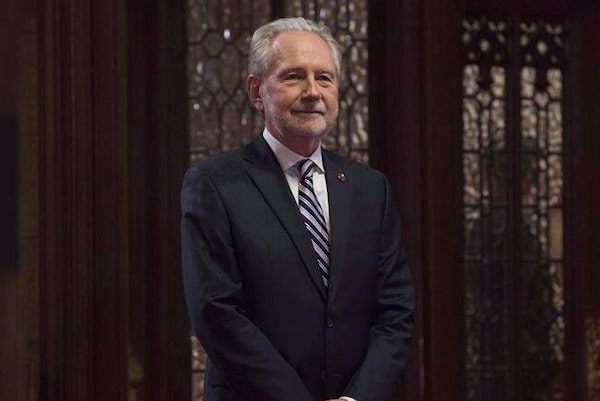
Senator Peter Harder waits in the Senate lobby in Ottawa on November 15, 2016. The federal government has opted to change course on its proposed legislation designed to end sex-based discrimination in the Indian Act.Adrian Wyld/The Canadian Press
The federal government is promising to remove the last vestiges of sexism from the Indian Act that, for more than a century, have made it easier for men than for women to pass their status to their descendants.
It is a change that comes at the insistence of senators who refused to pass a bill allowing the discrimination to continue.
The Liberal government drafted the legislation known as Bill S-3 last year in response to a ruling by a Quebec judge who found that some of the sex-based discrimination in the Indian Act, which was first introduced in 1876, violates the Canadian Charter of Rights and Freedoms.
Read more: Looking to move beyond the Indian Act, can Canada shed its 'colonial structures?'
As it was originally written, the bill removed some sexist parts of the Act, but it did not change the fact that people fathered by status men before Sept. 4, 1951, when the Indian register was created, would get status and could pass it on to their offspring, while status women who married non-status men and had children before that date could not. It is is known as the 1951 cutoff.
The Senate said that was unacceptable and unanimously approved an amendment last spring that removed that sexism, over the government's objections. The government tried to restore it, saying there would be an additional re-examination of the Indian Act once it complied with the Quebec court ruling. But the Senate made it clear it would not readily give in.
Faced with the prospect of a prolonged fight in which it would be seen to be arguing in favour of discriminatory treatment of Indigenous women, the government backed down. It has now created its own amendments to Bill S-3 that it says will have the same effect as the one proposed by the Senate.
"The government has listened to the argument put forward by the Senate, as well as some Indigenous voices," Peter Harder, the Liberal government's representative in the Senate, said in the Red Chamber on Tuesday after reading the government's proposed amendments.
While most of the provisions of Bill S-3 will come into effect immediately after it becomes law, the clause dealing with the cutoff will be brought into force after consultations with First Nations that will begin next year, Mr. Harder said.
"Colleagues, let me be clear, these consultations are about how to remove the 1951 cutoff, not whether to do it," said Mr. Harder, who added that the legislation requires the government to report back to Parliament within 12 months to explain how consultations are proceeding.
Some First Nations may object to being forced to divide their limited land and resources among greater numbers of people as women and their offspring who were previously disenfranchised regain their status. It is also unknown how many people will be affected.
There are now about 900,000 people who have Indian status. Some estimates suggest that removing the 1951 cutoff could mean between 750,000 and 1.3 million people are added to this number. That could be costly given that status Indians receive tax breaks, postsecondary tuition and medical benefits that other Canadians do not.
But the government believes those numbers significantly overestimate the number of people who would successfully obtain Indian status, Mr. Harder said.
The senators' concerns about the discriminatory elements in Bill S-3 were expressed most vociferously by the members of the Senate committee on Aboriginal peoples.
Lillian Dyck, the senator who chairs that committee, was tearful with joy while talking about the fact the government will change the bill in response to the Senate's demands.
"If we pass S-3 as amended by today's motion, all of the female sex-based discrimination will be eliminated in the Indian Act," Ms. Dyck said. "Those who lost status before Sept. 4, 1951, will also be able to gain it back."
This is a "major accomplishment," she said. Although Ms. Dyck said she is somewhat concerned that the 1951 cutoff will remain for the time being, she said she is comforted by the fact that the clauses that will remove it are actually in the amendment.
Shelagh Day, chair of the human-rights committee of the Canadian Feminist Alliance for International Action, which lobbied hard to have the sexism removed from the Indian Act, she is concerned that here is no specific date set for removing the 1951 cutoff.
But, Ms. Day said, it sounds like a positive step forward. "It sounds as though the government is conceding that there is still discrimination in the Indian Act that must be removed."